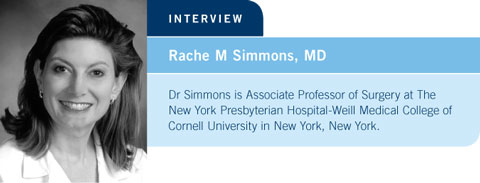
 |
||||||||||||||

| Tracks 1-9 | ||||||||||||||||||||
|
Select Excerpts from the Interview
Track 2
![]() DR SIMMONS: One particularly exciting area is alternatives to surgical
lumpectomy, such as percutaneous excision. Several devices currently on the
market do a good job of excising lesions. At this point, they’re only approved
to excise benign lesions, but it wouldn’t surprise me if, in the future, we see
these technologies used to excise breast tumors as an alternative to surgical
lumpectomy.
DR SIMMONS: One particularly exciting area is alternatives to surgical
lumpectomy, such as percutaneous excision. Several devices currently on the
market do a good job of excising lesions. At this point, they’re only approved
to excise benign lesions, but it wouldn’t surprise me if, in the future, we see
these technologies used to excise breast tumors as an alternative to surgical
lumpectomy.
Several ablation therapy technologies are currently available and are being evaluated in the treatment of primary breast cancer. These include laser ablation, radiofrequency (RF) ablation and cryoablation. Two other modalities being evaluated are focused ultrasound and microwave, for which we have limited data. The two heat technologies — laser and RF — have been shown to be pretty good at killing cancer. I find cryoablation most interesting. Good data evaluating cryoablation in the treatment of fibroadenomas have emerged. We started using it years ago and have accumulated enough data that it’s now FDA approved to treat fibroadenomas without resection.
Currently, one pilot study is applying this technology to breast tumors. In 27 patients with T1 invasive breast tumors, we performed cryoablation and then a resection. We found that if we limited the patients to those with purely invasive ductal carcinoma, without extensive intraductal components and with tumors smaller than 1.5 centimeters, we achieved 100 percent complete ablation (Sabel 2004).
Track 7
![]() DR SIMMONS: We’ve been talking about what we can do from an oncologically
safe perspective to maximize the cosmetic results for patients who require
a mastectomy. Skin-sparing mastectomy has been around for a decade, and
multiple studies demonstrate that skin sparing is oncologically as safe as a
nonskin-sparing mastectomy, except for patients with inflammatory cancer.
DR SIMMONS: We’ve been talking about what we can do from an oncologically
safe perspective to maximize the cosmetic results for patients who require
a mastectomy. Skin-sparing mastectomy has been around for a decade, and
multiple studies demonstrate that skin sparing is oncologically as safe as a
nonskin-sparing mastectomy, except for patients with inflammatory cancer.
Certainly we achieve better cosmetic results with those patients undergoing a skin-sparing mastectomy. When I talked to my patients about skin-sparing mastectomy, they used to ask, “Why do you have to take the nipple and areola?” The only data I could provide were old data suggesting that if you didn’t take the nipple-areola complex, you had a higher chance of recurrence. Of course, the nipple and the areola are different from one another. The nipple is the convergence of all the ductal tissue from the breast, and the areola is just different-colored skin that doesn’t have ductal glands.
So we conducted a study in which we evaluated how often the nipple and the areola were involved for more than 200 patients who underwent mastectomies (Simmons 2002) and discovered that the nipple was frequently involved, even for patients with ductal carcinoma in situ (DCIS). The areola, however, was almost never involved. We found that fewer than one percent of the patients had areolar involvement. These patients had large, invasive breast tumors located right behind the areola. I’ve modified my skin-sparing mastectomy to be, for many patients, an areola-sparing mastectomy.
| Table of Contents | Top of Page |